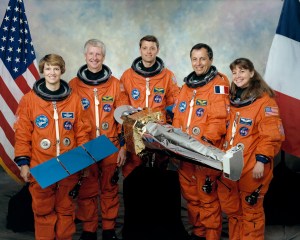In April 1973, preparations to launch America’s first space station intensified at NASA’s Kennedy Space Center (KSC) in Florida with the final rollout of a Saturn V rocket, carrying the Skylab 1 space station, to Launch Pad 39A.
In April 1973, preparations to launch America’s first space station intensified at NASA’s Kennedy Space Center (KSC) in Florida with the final rollout of a Saturn V rocket, carrying the Skylab 1 space station, to Launch Pad 39A. The large rocket joined the smaller Saturn IB to launch the first crew to the station, already undergoing testing at nearby Launch Pad 39B, marking the first and only time two Saturn rockets occupied both pads. In a first at Launch Complex 39, engineers completed a dual countdown demonstration test for the two vehicles, planned to launch one day apart on May 14 and 15, dates confirmed by NASA management. Skylab 2 Commander Charles “Pete” Conrad, Scientist Pilot Dr. Joseph P. Kerwin, and Pilot Paul J. Weitz completed their training as their launch and 28-day mission aboard the station approached.



Three views of the Saturn V rocket with the Skylab 1 space station mounted on top as it exits the Vehicle Assembly Building at NASA’s Kennedy Space Center in Florida to begin the three-mile journey to Launch Pad 39A.
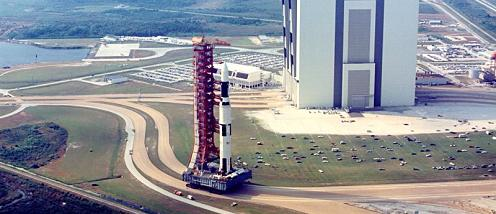
Panoramic aerial view of the Saturn V carrying the Skylab 1 space station as it leaves the Vehicle Assembly Building at NASA’s Kennedy Space Center in Florida on its way to Launch Pad 39A.
Following a two-day comprehensive review by senior NASA managers of the readiness of the Skylab program, on April 4 Skylab Program Director William C. Schneider formally set the launch dates of May 14, 1973, for the Skylab 1 space station, and May 15 for Skylab 2, the first crew to occupy the station for a planned 28-day stay. The planning launch dates for Skylab 3 and Skylab 4, the second and third crewed missions, remained Aug. 8 and Nov. 9, respectively. In KSC’s Vehicle Assembly Building (VAB), workers finished the assembly of the Saturn V vehicle with the addition of the nose cone to the payload shroud on April 8, and eight days later rolled the stacked rocket on its Mobile Launcher to Launch Pad 39A. Since workers assembled the rocket in the VAB’s High Bay 2, the rollout took an unusual route from the rear of the building around to the front before the transporter reached the crawlerway to the launch pad. Only Apollo 10 and 13, also assembled in High Bay 2, made similar journeys. At Pad 39A, the Saturn V joined its smaller cousin, the Saturn IB for the Skylab 2 crew, at Pad 39B since Feb. 26, the first time rockets sat on both pads simultaneously. Workers at Pad 39B loaded propellants into the Apollo spacecraft on April 19 and filled the Saturn IB rocket’s first stage tank with kerosene on April 23.


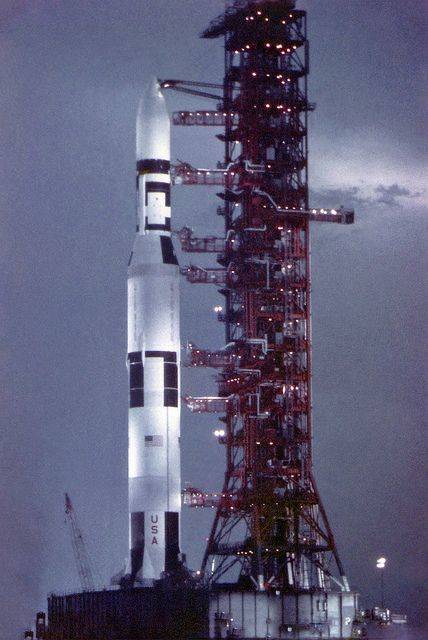

Left: The Saturn V with the Skylab 1 space station on its way to from the Vehicle Assembly Building to Launch Pad 39A. Middle left and middle right: Two views of the Skylab 1 Saturn V after arriving at Launch Pad 39A. Right: The Skylab 1 Saturn V on Launch Pad 39A in the foreground, with the Skylab 2 Saturn IB on Launch Pad 39B about one mile distant in the background.
As workers prepared the two vehicles and their spacecraft for launch, senior NASA managers met for the Flight Readiness Review at KSC. At the end of the review on April 20, Program Director Schneider stated that while some work still remained, everything looked good for on-time launches of the two rockets. On April 26, engineers in the Launch Control Center (LCC) began the Countdown Demonstration Test (CDDT), essentially a dress rehearsal for the countdown leading to the launch itself. They conducted two parallel countdowns, one for the Saturn V monitored in the LCC’s Firing Room 2 and culminating in a simulated liftoff on May 2, and another one for the Saturn IB from Firing Room 3 ending with a simulated liftoff on May 3. Workers at the pad completed final stowage into the Skylab’s modules and closed the hatches on May 1.




Parallel countdown demonstration tests. Engineers in Firing Room 2 of the Launch Control Center, left, monitor the test for the Skylab 1 Saturn V at Launch Pad 39A, middle left, while engineers in Firing Room 3, middle right, monitor the Skylab 2 test at Pad 39B, right.
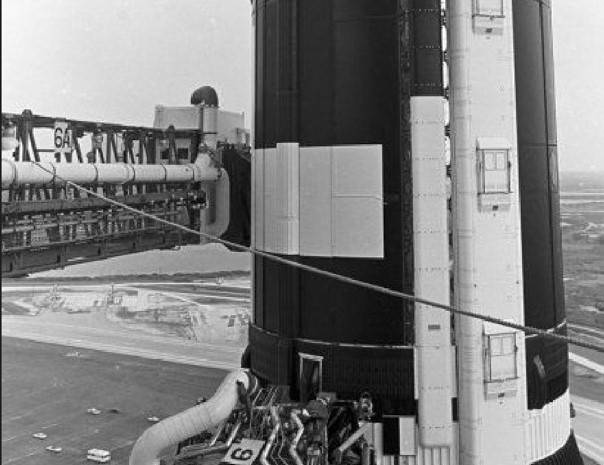

Left: At Launch Pad 39A, close up view of the Skylab Orbital Workshop (OWS) taken from the Launch Umbilical Tower, showing the swing arm used to access the station through a side hatch. Right: Close out photo of the OWS taken shortly before workers closed the hatches.
The schedule for Conrad, Kerwin, and Weitz during the final month of training remained busy. On April 17, they answered reporters’ questions during their preflight press conference at NASA’s Johnson Space Center (JSC) in Houston. One week later, they, along with their backups Russell L. “Rusty” Schweickart, Dr. F. Story Musgrave, and Bruce McCandless, began their preflight medical isolation, formally known as the Skylab Flight Crew Health Stabilization Program. For the last three weeks before their launch, the program restricted the astronauts to certain areas at JSC and KSC required for training, exercise, physical exams, and of course flying, and limited their exposure only to personnel who passed strict medical examinations. In one example of how planners implemented this plan, on April 25 all three Skylab crews received a briefing from the Smithsonian Institution regarding identification of short-lived terrestrial phenomena for the astronauts to photograph. To minimize contact with personnel, the Skylab 2 astronauts participated in the briefing remotely via closed-circuit television. On May 4, Conrad, Kerwin, and Weitz took part in the final stage of the CDDT at KSC, called the “dry” stage because workers drained the rocket’s fuel tanks, suiting up and boarding their spacecraft at the launch pad as they would on launch day.


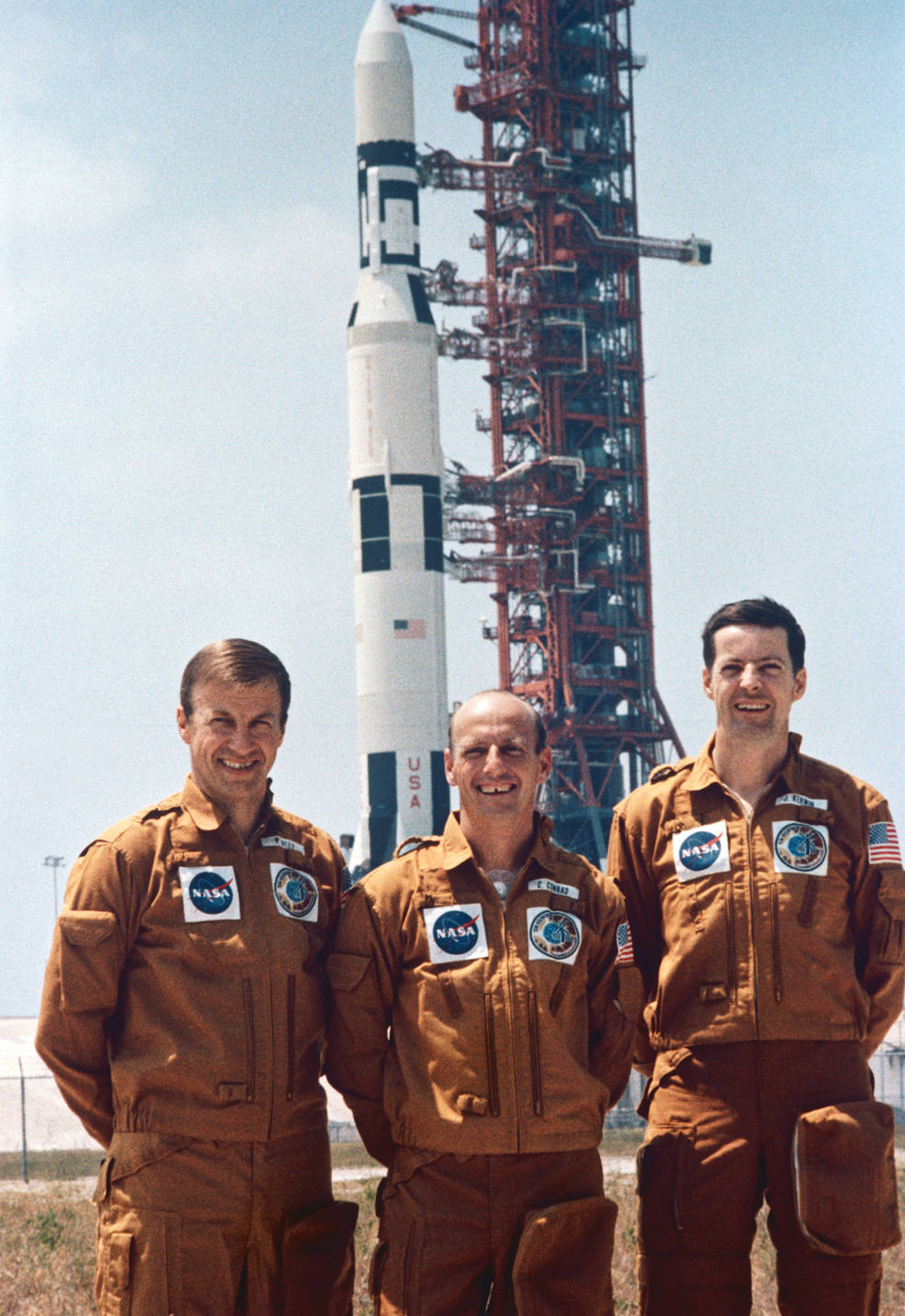
Left: Skylab 2 astronauts Charles “Pete” Conrad, left, Paul J. Weitz, and Dr. Joseph P. Kerwin during their preflight crew press conference. Middle: Kerwin, left, and Conrad training in the Skylab Orbital Workshop trainer at NASA’s Johnson Space Center. Right: Weitz, Conrad, and Kerwin pose in front of the Skylab 1 Saturn V at Launch Pad 39A
following the Countdown Demonstration Test.


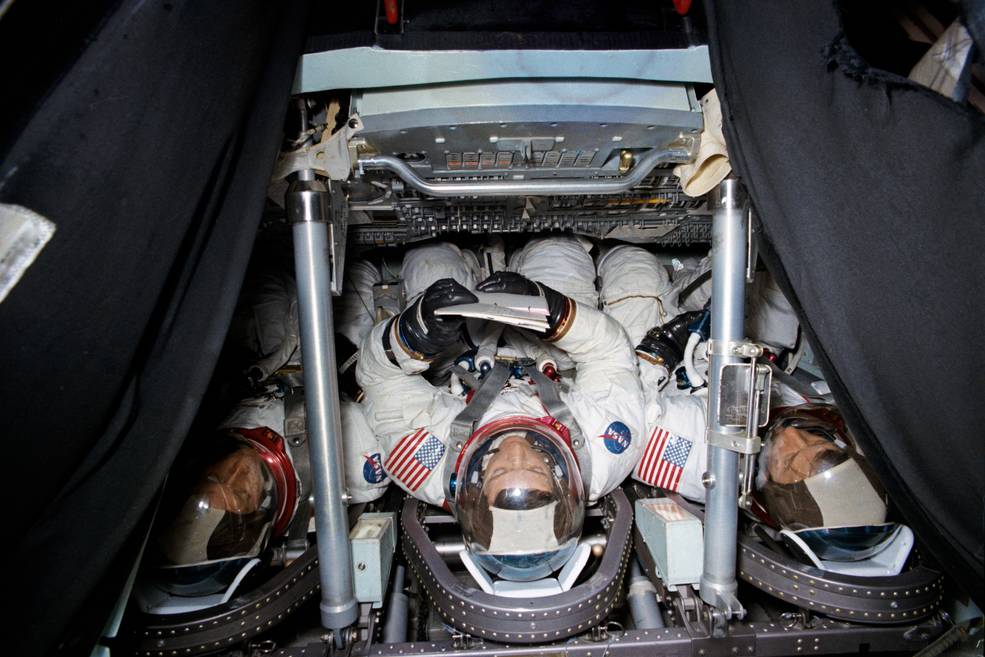
Left: Skylab 2 Commander Charles “Pete” Conrad, left, assists Pilot Paul J. Weitz with donning his spacesuit in preparation for a suited run in the Apollo Command Module (CM) simulator at NASA’s Johnson Space Center (JSC) in Houston. Middle: Weitz, right, assists Skylab 2 Scientist Pilot Dr. Joseph P. Kerwin with his suit. Right: Conrad, left,
Kerwin, and Weitz in the CM simulator at JSC.

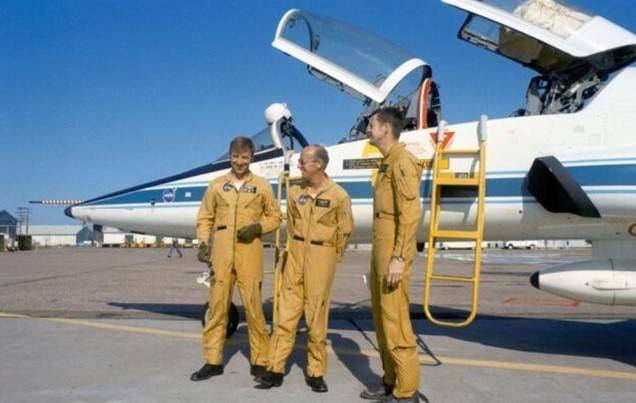
Left: Skylab 2 astronauts Dr. Joseph P. Kerwin, seated left, and Paul J. Weitz receive last minute solar physics instruction at NASA’s Johnson Space Center in Houston. Right: Weitz, Charles “Pete” Conrad, and Kerwin prepare to depart Ellington Air Force Base near NASA’s Johnson Space Center in Houston for NASA’s Kennedy Space Center in Florida two days before their planned launch.
Following last minute training at JSC, Conrad, Kerwin, and Weitz departed Houston’s Ellington Air Force Base on May 13 and flew their T-38 Talon jets to KSC for final preparations for launch. They observed the launch of Skylab 1 on May 14, but their plans changed following the failure of the station’s micrometeoroid shield and solar panels.
To be continued …
World events in April 1973:
April 2 – Launch of the LexisNexis computerized legal research system.
April 3 – The first phone call is made on a hand-held mobile phone.
April 4 – The World Trade Center, twin 110-story towers then the tallest in the world, opens in New York City.
April 5 – NASA’s Pioneer 11 spacecraft is launched to explore Jupiter and Saturn.
April 6 – Ron Bloomberg of the New York Yankees becomes the first designated hitter in Major League Baseball.
April 9 – Painter Pablo Picasso dies of a heart attack at age 91.
April 20 – The Canadian Anik A2 becomes the first commercial satellite (for Telesat Canada).


























